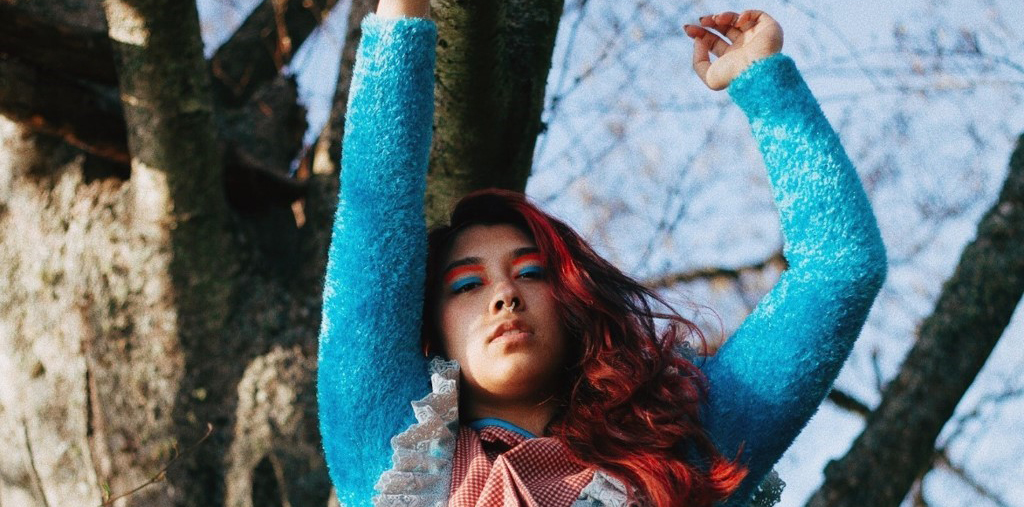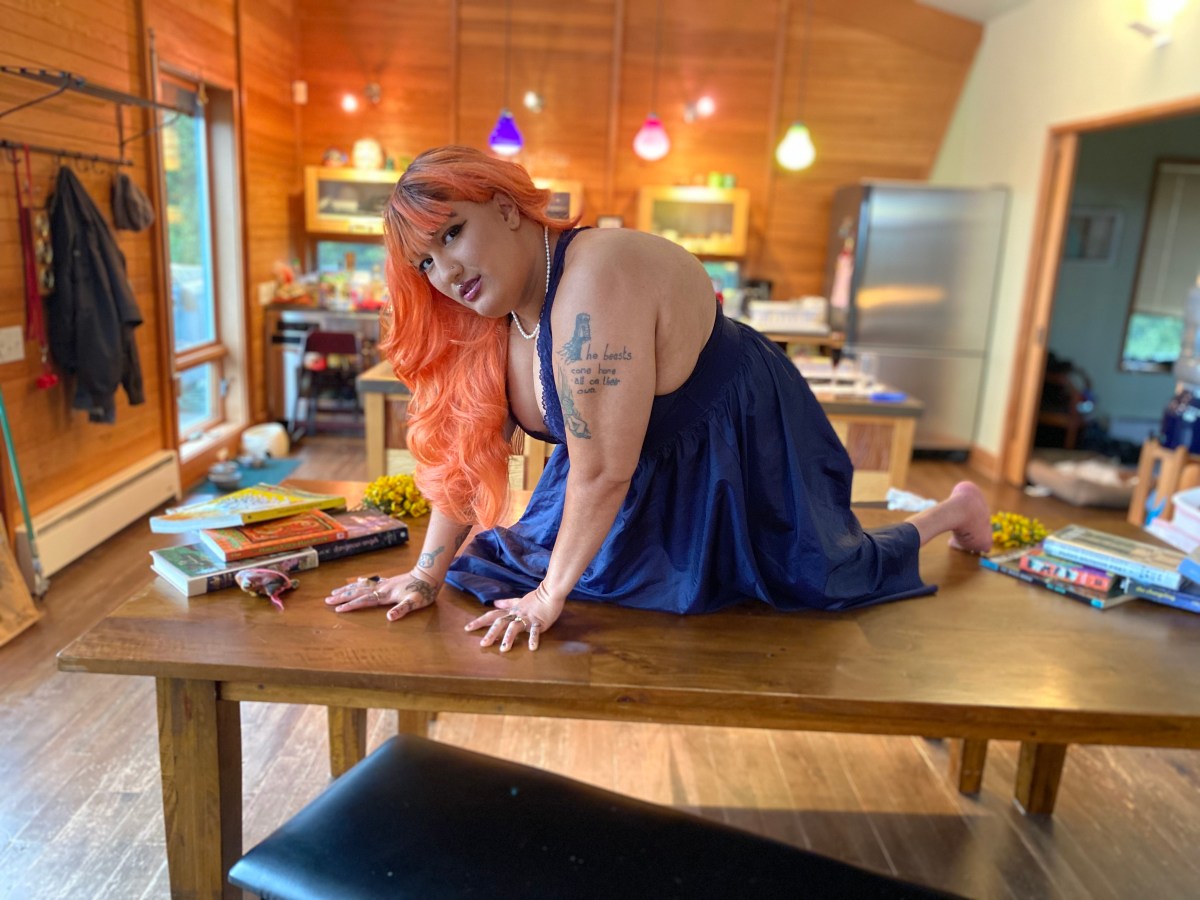COVID-19 has led to staggering loss of life and unthinkable worldwide disruption, yet the way many of us experience pandemic is through the restructuring of our societal choreography. We are asked to stay at home, to maintain a social distance of six feet, and to wear masks to protect ourselves and others. Whether we know it or not, we are grappling with questions dancers have been asking for a very long time: What does it mean to be embodied? What does it mean to inhabit a body in relation to others? What does that look like for queer and disabled bodies, Black bodies, or bodies of color?
Moonyeka, a movement-based, disabled Filipinx storyteller, is part of the Kapatid Kollective and founded What’s Poppin’ Ladiez? in 2017, from which came Lil Brown Girls Club (BGC), a movement-safe space for femmes and girls of color. They still facilitate BGC online, and have other virtual offerings centered around kink education, erotic energy and healing, but their personal work is on pause.

Disabled, Filipinx femme movenent-based storyteller Moonyeka says, “There are reasons why QTPOC are resilient as fuck.” Photo by Hannahbaum for Janelle Abbott’s line Ugly Prairie.
“What makes it really difficult to create right now is I’m being asked to make things by myself or at a distance, and that’s really triggering, especially when you’re in diaspora all the time. I already had to be extremely savvy and resourceful pre-COVID-19. I didn’t have the capacity to be doubly savvy and resourceful for the sake of storytelling. I was okay with just allowing myself time to survive and get my basic needs met,” Moonyeka explained. “But you want answers, but you want visions. There’s something exploitive that I feel happens to specifically [queer and trans people of color] artists during this time. Everyone’s kind of looking to the culture-bearers, and the storytellers, and the lightworkers, right? And it’s sort of, do we even want to engage with that right now? What are we figuring out? Figuring out how to make capitalism work? No! That’s what the asks sound like,” they emphasized.
Dance is a powerful means of connection for queer and trans people. Queer and trans communities of Black and Latinx descent helped shape modern formulations of disco, house, and techno. Further, the ballroom scene in New York, immortalized in Paris is Burning and now Pose, is the birthplace of popular choreography. “Most — perhaps nearly all — of the dance moves you see in R&B and pop videos today come from choreographers who have been involved in ballroom culture,” Luis Manuel-Garcia wrote for Resident Advisor. With club and dance culture are so entrenched in LGBTQ+ community, how can we maintain that powerful source of connection during a pandemic?
Dance requires intimacy, with your own body, and those of your partners. The history of trans embodiment in particular comes with the devastating histories of pathology and abuse. Voguing is a way to fight that oppression through freedom. The movements in voguing are an interpretation of carving out space for femme or other marginalized identities in a hostile world. If trans people have found safer spaces within dance, COVID-19 has taken that away for the foreseeable future.
“The ease of being able to be in a studio with another person, touch them, and vibe off of them, and really be up in each others’ bodies as dancers often are, is definitely a big thing that I miss,” they said,” said NEVE, a choreographer and multidisciplinary artist. “I feel like as a dancer, I’m so grateful that I’m queer, that I’m POC, and that I’m disabled because my disabled community especially has already made it a part of being together that some people might not be there in person. They might be there via video chat, or on the phone, if a space isn’t going to be accessible to them, or if they are not going to be able to get out of bed that day.”
NEVE is a recently-awarded Pina Bausch Fellow, one of the first two Americans to receive the award. The fellowship partners emerging choreographers and dancers with established ones. Due to COVID-19, their fellowship year is not exactly what he expected. NEVE was supposed to live in Oakland, California for three months to work with Mark Brew of Axis Dance Company on a work in progress. With travel out of the question, they have Zoom meetings with Brew and other collaborators.
They continue to teach Open Level Improvisation (for lovers alone) online through Velocity Dance Center every Friday, and have expanded their skill set to include personal training and certified nutrition coaching. He also continues to work on upcoming performances like their “The Exorcism of Snow,” which combines poetry, storytelling, dance, and puppetry. “The Exorcism of Snow” is slated for January, and might be in-person or online depending on the state of the pandemic.

“I’m a part of communities that are not being taken care of, so when something like [COVID-19] comes up, our response immediately is ‘How do we take care of each other?’” said choreographer and dancer Neve Kamilah Mazique-Ricardi (NEVE). Photo by Tony Mazique-Ricardi.
IRL choreography might be off-limits, but our virtual queer and trans bodies have yet to be fully explored. Video editing and effects from filters to overlays can lead to new digital experiences, and that’s just the beginning. We are becoming more adept at virtual communions. “People are going to keep trying to find ways to dance together no matter what,” Johnson affirms.
Virtual communions are just what the collective By Us For Us is facilitating. BUFU is a digital queer space that builds mutual aid networks, and generates “digital intimacy” through Zoom meetings, including a global 24-hour dance party that happened on March 28.
While the pandemic has hit queer and trans communities especially hard, our trans artists have grounded us in what’s important. Foundation to our resilience is our interconnectedness, what Moonyeka and Filipinx communities call kapwa — a word from Tagalog loosely translated to “shared identity” or “shared inner self.” Quarantine may have cut off physical interactions, but Moonyeka finds connectivity not only online, but through embodied commitment.
“Just be with whatever those wants and desires and dreams are, because those are interconnected to the collective world, which is related to kapwa — the interconnection,” they observed. “Your embodied commitment is interrelated to yourself and others, the land, the sky, your very embodied, ancestral, old, generational histories, and your descendants. That’s what I’ve been holding onto during this time.”


